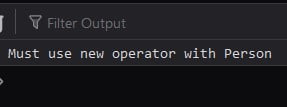JavaScript’s new target meta property detects whether a function or constructor was called using the new operator. The new.target consists of the new keyword, a dot, and target property. The new.target is available in all functions.
new.targetJavaScript new target
Simple example code determines at runtime whether a function or constructor was called using the new keyword or not.
functions
Detect whether a function was called with new as a constructor.
function Foo() {
if (!new.target) { throw 'Foo() must be called with new' }
console.log('Foo instantiated with new')
}
new Foo() // logs "Foo instantiated with new"
Foo() // throws "Foo() must be called with new"<!DOCTYPE html>
<html>
<body>
<script>
function Person(name) {
if (!new.target) {
throw "Must use new operator with Person";
}
this.name = name;
}
try {
Person();
} catch (e) {
console.log(e);
}
</script>
</body>
</html> Output:

Constructors
<script>
class Person {
constructor(name) {
this.name = name;
console.log(new.target.name);
}
}
class Employee extends Person {
constructor(name, title) {
super(name);
this.title = title;
}
}
let john = new Person('John Doe');
let lily = new Employee('Lily Bush', 'Programmer');
</script>Do comment if you have any doubts or suggestions on this JS pseudo-property topic.
Note: The All JS Examples codes are tested on the Firefox browser and the Chrome browser.
OS: Windows 10
Code: HTML 5 Version